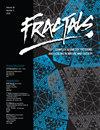分数阶q-积分-差分方程非线性多项脉冲反周期边值问题的研究
IF 2.9
3区 数学
Q1 MATHEMATICS, INTERDISCIPLINARY APPLICATIONS
Fractals-Complex Geometry Patterns and Scaling in Nature and Society
Pub Date : 2023-10-20
DOI:10.1142/s0218348x23401916
引用次数: 0
摘要
本文引入并研究了一类新的非线性多项脉冲反周期边值问题,涉及Caputo型分数型[公式:见文]-不同阶导数算子和Riemann-Liouville分数型[公式:见文]-积分算子。利用Banach不动点定理证明了给定问题解的唯一性。应用类shaefer不动点定理,得到了该问题的存在性结果。为说明所得结果,构造了实例。本文最后提出了一些有趣的观察结果,即在适当选择控制方程中所涉及的参数的情况下,将文中证明的结果简化为一些新的结果。本文章由计算机程序翻译,如有差异,请以英文原文为准。
Investigation of a nonlinear multi-term impulsive anti-periodic boundary value problem of fractional q-integro-difference equations
In this paper, we introduce and investigate a new class of nonlinear multi-term impulsive anti-periodic boundary value problems involving Caputo type fractional [Formula: see text]-derivative operators of different orders and the Riemann–Liouville fractional [Formula: see text]-integral operator. The uniqueness of solutions to the given problem is proved with the aid of Banach’s fixed point theorem. Applying a Shaefer-like fixed point theorem, we also obtain an existence result for the problem at hand. Examples are constructed for illustrating the obtained results. The paper concludes with certain interesting observations concerning the reduction of the results proven in the paper to some new results under an appropriate choice of the parameters involved in the governing equation.
求助全文
通过发布文献求助,成功后即可免费获取论文全文。
去求助
来源期刊
CiteScore
7.40
自引率
23.40%
发文量
319
审稿时长
>12 weeks
期刊介绍:
The investigation of phenomena involving complex geometry, patterns and scaling has gone through a spectacular development and applications in the past decades. For this relatively short time, geometrical and/or temporal scaling have been shown to represent the common aspects of many processes occurring in an unusually diverse range of fields including physics, mathematics, biology, chemistry, economics, engineering and technology, and human behavior. As a rule, the complex nature of a phenomenon is manifested in the underlying intricate geometry which in most of the cases can be described in terms of objects with non-integer (fractal) dimension. In other cases, the distribution of events in time or various other quantities show specific scaling behavior, thus providing a better understanding of the relevant factors determining the given processes.
Using fractal geometry and scaling as a language in the related theoretical, numerical and experimental investigations, it has been possible to get a deeper insight into previously intractable problems. Among many others, a better understanding of growth phenomena, turbulence, iterative functions, colloidal aggregation, biological pattern formation, stock markets and inhomogeneous materials has emerged through the application of such concepts as scale invariance, self-affinity and multifractality.
The main challenge of the journal devoted exclusively to the above kinds of phenomena lies in its interdisciplinary nature; it is our commitment to bring together the most recent developments in these fields so that a fruitful interaction of various approaches and scientific views on complex spatial and temporal behaviors in both nature and society could take place.

 求助内容:
求助内容: 应助结果提醒方式:
应助结果提醒方式:


